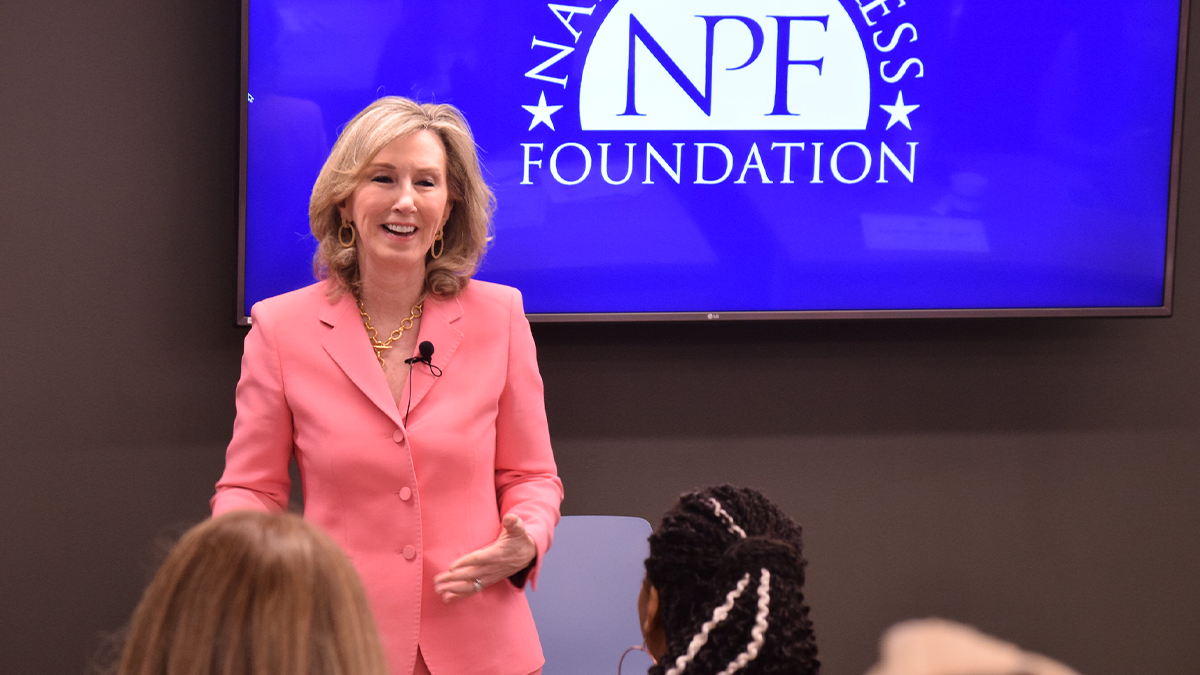Women hold an average of 33% of legislative seats – the highest percentage in the nation’s history, according to Martha Saenz, the Associate Director of the Quad Caucus and Women’s Legislative Network, an affiliate of the National Conference of State Legislatures. She spoke to the National Press Foundation’s Covering Women in Politics fellows about the breakdown of women legislators.
“The total number of women legislative seats is 2,460,” said Saenz – out of an overall number of 7,386. “It’s give or take, at any given day, there’s sometimes a seat will fall off, somebody will retire, somebody will leave office.”
Nevada has the highest percentage of women legislators with 60%.
“It hit that milestone in 2018… but they only convene every other year. So, they convene in odd years.”
But the number of women in political seats doesn’t automatically translate into power or prestige.
“One of the challenges, of course, is when we’re looking at women serving, are they serving in states where there’s a higher salary, where maybe they don’t have to go to the capital every year, are they serving in areas where maybe they live closer to the capital, right? So do we see more concentrated representation in urban areas or closer to the capital itself? Because it would be rather hard for someone who’s managing, trying to balance family and everything else with going to a state capital if it’s in a rural area.”
The state with the lowest percentage of women legislators is West Virginia, Saenz said. “11.7% are women in West Virginia, 16 out of 134. Not a lot, but they weren’t always there.” U. S. territories are also included in NCSL data, Saenz said.
In the 2023 legislative session, 97 women serve as either the speaker of the House, president of the Senate, speaker pro tem, Senate president pro tem, majority leader or minority leader, Saenz said.
But despite relative progress, retention remains a problem for women’s political seats. “In general, we’re seeing that legislative leaders are not around as long as they used to be,” Saenz said. Historically, legislative leaders have held their posts between 12 to 20, years. Today, the longest tenure is for a retiring representative from Mississippi who has been there for 12 years.
Saenz said that the Women Legislative Network is interviewing some women legislators to ask about the turnovers and how strategies to support their political careers can be developed.
For a breakdown of women in leadership, visit NCSL’s guide.
Use the women’s caucus as a resource, Saenz said.
Over 30 states have a women’s caucus. NSCL tracks whether they are policy caucuses and if they’re informal or formal.
“Informal meaning do they just gather for the sake of having a support network within the legislature to not feel isolated because there’s fewer women?” she said. “In other cases, it’s a more formal gathering where they serve as mentors.”
Hawaii convenes a policy focus caucus, Saenz said. Every year, they introduce a complete bipartisan package of bills related to women.
“For 2023, they gathered and decided, ‘You know what? We really want to address some issues,’ and they addressed human trafficking, improvements in childcare and safeguarding access to reproductive health.”
If you’re looking for information about women in legislatures, go to their resource or staff person to get historical context.
Women of color legislators are working together.
Saenz also works with the Quad Caucus – a collaborative body consisting of the National Hispanic Caucus of State Legislators, the National Caucus of Native American State Legislators, the National Asian Pacific American Caucus of State Legislators and the National Black Caucus of State Legislators. For the first time in history, women are leading each of the caucuses.
“…They wanted to focus on specific areas that impact women of color,” Saenz said. “So the Native caucus said, ‘Let’s all get together, come with unified messaging on particular issue areas.’ The Native caucus identified violence against women, mostly looking at issues of missing and murdered indigenous women…. President Laura Hall from Alabama looked at maternal health, so infant mortality and maternal mortality… Delegate Valderrama in Maryland wanted to focus on women as caregivers… Representative Angela Romero… wanted to focus on wage gaps.”
Access the full transcript here.
This program is funded by Pivotal Ventures. NPF is solely responsible for the content.







